I'm an artist & blogger on mihokishares.com ☀ I created this blog to share both my notes from my Art History class and artworks I like from other artists ♥ // Join me! @mihokishares
Don't wanna be here? Send us removal request.
Text
Giovanni Battista Piranesi (1720 - 1775)
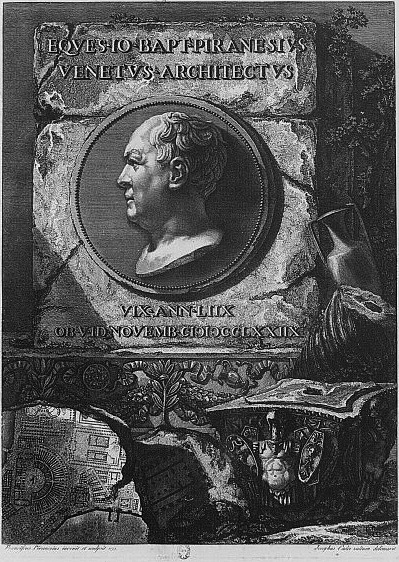
Self-Portrait
Nationality: Italian
Art Movement: Baroque, Neoclassicism
Genre: cityscape
Field: architecture, etching
Giovanni Battista (or Giambattista) Piranesi was an Italian draftsman, printmaker, architect, and art theorist. His large prints depicting the buildings of classical and postclassical Rome and its vicinity contributed considerably to Rome’s fame and to the growth of classical archaeology and to the Neoclassical movement in art.
He created about 2,000 plates in his lifetime. The “Prisons” (Carceri) of about 1745 are his finest early prints; they depict ancient Roman or Baroque ruins converted into fantastic, visionary dungeons filled with mysterious scaffolding and instruments of torture.
His unparalleled accuracy of depiction, his personal expression of the structures’ dramatic and romantic grandeur, and his technical mastery made these prints some of the most original and impressive representations of architecture to be found in Western art.
- Britannica
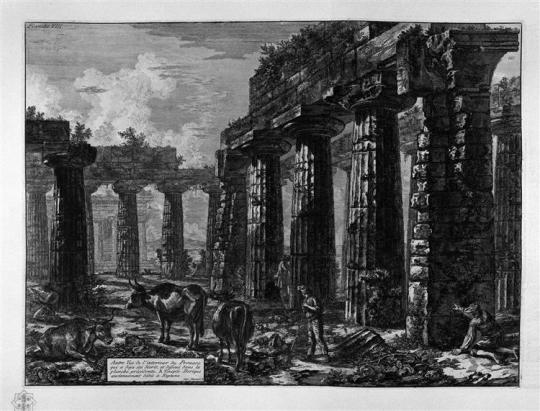
Another extension as above
Giovanni Battista Piranesi
Original Title: Altro interno come sopra
Date: 1778
Style: Neoclassicism
Genre: capriccio
Tag: ruins-and-columns, Rome
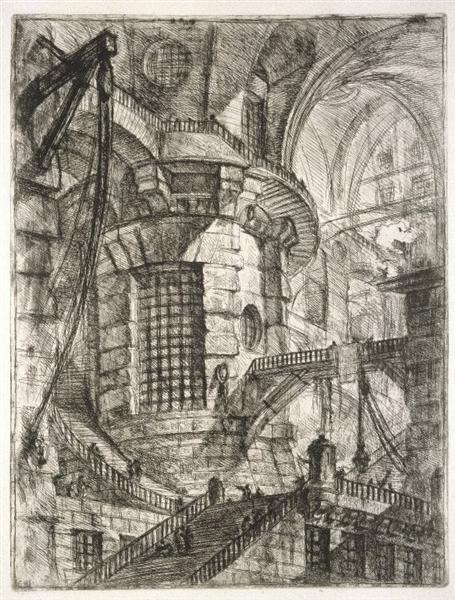
The Round Tower, plate III from `Carceri d`Invenzione`
Giovanni Battista Piranesi
Date: 1749
Style: Neoclassicism
Genre: cityscape
Media: etching
Location: Brooklyn Museum, New York City, NY, US
Dimensions: 41.3 x 54.6 cm
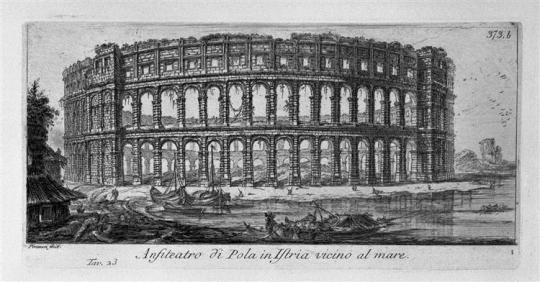
Arch of Drusus and the door of St Sebastian in Rome
Giovanni Battista Piranesi
Date: 1748
Style: Neoclassicism
Genre: cityscape
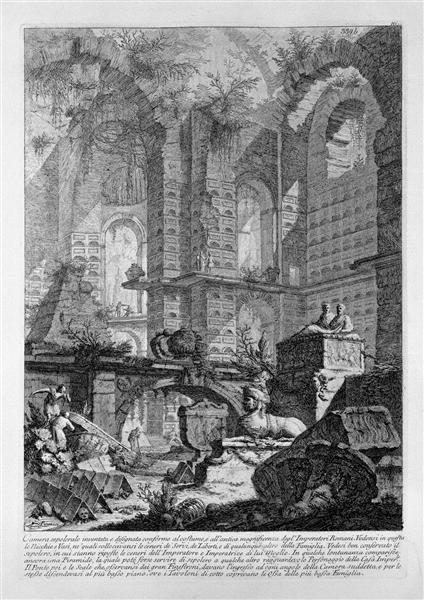
Burial chamber invented and designed in accordance with the custom and the ancient Roman emperors magnificence
Giovanni Battista Piranesi
Date: 1742
Style: Neoclassicism
Genre: cityscape
Tag: Rome, cemeteries-and-tombs
- WikiArt
#art#art history#art history class#art history with Mihoki#piranese#giovanni battista piranesi#etching#architecture#cityscape#neoclassicism#xviii century#italian artist#ruins#rome#capriccio#columns#baroque
2 notes
·
View notes
Text
Henry Fuseli (1741 - 1825)
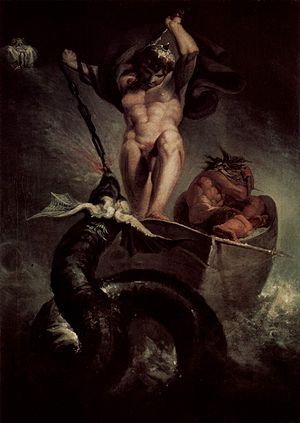
Thor Battering the Midgard Serpent - 1790
Johann Heinrich Füssli (Henry Fuseli) was a Swiss painter, draughtsman, and writer on art who spent much of his life in Britain.
Fuseli is famous for his paintings and drawings of nude figures caught in strained and violent poses suggestive of intense emotion.
He also had a penchant for inventing macabre fantasies, such as that in The Nightmare.
Always drawn to literary and theatrical subjects, Fuseli developed a special interest in illustrating Shakespeare.
He painted works for John Boydell's Shakespeare Gallery, and created his own "Milton Gallery". He held the posts of Professor of Painting and Keeper at the Royal Academy.
His style had a considerable influence on many younger British artists, including William Blake.
- Wikipedia
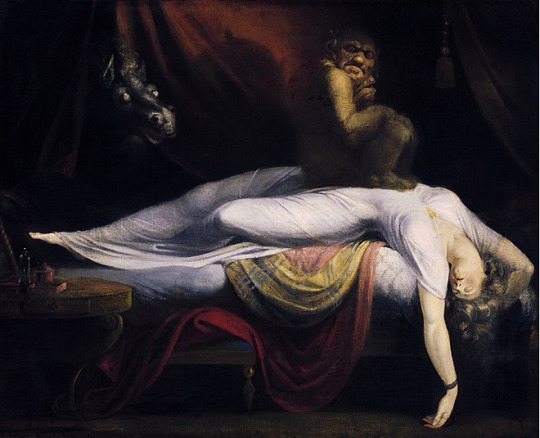
The Nightmare
Artist: Johann Heinrich Füssli
Year: 1781
Medium: Oil on canvas
Dimensions: 101.6 × 127 cm
Location: Detroit Institute of Arts
The painting's dreamlike and haunting erotic evocation of infatuation and obsession was a huge popular success.
After its first exhibition, at the 1782 Royal Academy of London, critics and patrons reacted with horrified fascination and the work became widely popular, to the extent that it was parodied in political satire and an engraved version was widely distributed. In response, Fuseli produced at least three other versions.
Interpretations vary. The canvas seems to portray simultaneously a dreaming woman and the content of her nightmare.
The incubus and horse's head refer to contemporary belief and folklore about nightmares but have been ascribed more specific meanings by some theorists.
Contemporary critics were taken aback by the overt sexuality of the painting since interpreted by some scholars as anticipating Jungian ideas about the unconscious.
It depicts a sleeping woman draped over the end of a bed with her head hanging down, exposing her long neck. She is surmounted by an incubus that peers out at the viewer. The sleeper seems lifeless and, lying on her back, takes a position then believed to encourage nightmares.
Her brilliant coloration is set against the darker reds, yellows, and ochres of the background; Fuseli used a chiaroscuro effect to create strong contrasts between light and shade.
The interior is contemporary and fashionable and contains a small table on which rests a mirror, vial, and book. The room is hung with red velvet curtains which drape behind the bed. Emerging from a parting in the curtain is the head of a horse with bold, featureless eyes.
For contemporary viewers, The Nightmare invoked the relationship of the incubus and the horse to nightmares. The work was likely inspired by the waking dreams experienced by Fuseli and his contemporaries, who found that these experiences related to folkloric beliefs like the Germanic tales about demons and witches that possessed people who slept alone.
In these stories, men were visited by horses or hags, giving rise to the terms "hag-riding" and "mare-riding", and women were believed to engage in sex with the devil.
The early meaning of "nightmare" included the sleeper's experience of weight on the chest combined with sleep paralysis, dyspnea, or a feeling of dread. The painting incorporates a variety of imagery associated with these ideas, depicting a mare's head and a demon crouched atop the woman.
Sleep and dreams were common subjects for the Zürich-born Henry Fuseli, though The Nightmare is unique among his paintings for its lack of reference to literary or religious themes (Fuseli was an ordained minister).
- Wikipedia
#art#swiss artist#swiss painter#art history#art history class#art history with Mihoki#artist#oil on canvas#xviii century#nightmare#fantasy#chiaroscuro#mythology#monsters#füssli#henry fuseli
43 notes
·
View notes
Text
Hubert Robert (1733 - 1808)
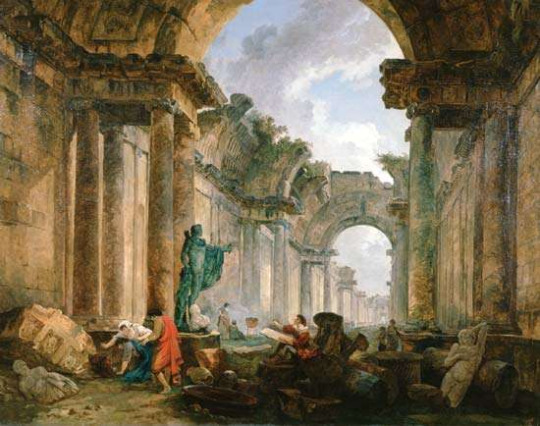
Imaginary View of the Grand Gallery of the Louvre in Ruins - 1796
Hubert Robert was a French painter, noted for his landscape paintings and Capriccio (architectural fantasy), or semi-fictitious picturesque depictions of ruins in Italy and of France.
He is called Robert des Ruines because of his many romantic representations of Roman ruins set in idealized surroundings.
A true man of the Enlightenment and one of the greatest creators of poetic images, Hubert Robert followed a remarkable artistic path that led him from Rome in the mid-18th century to the French court, where he produced some of the most spectacular decors in the brilliant decade that preceded the Revolution.
- Wikipedia & The Louvre
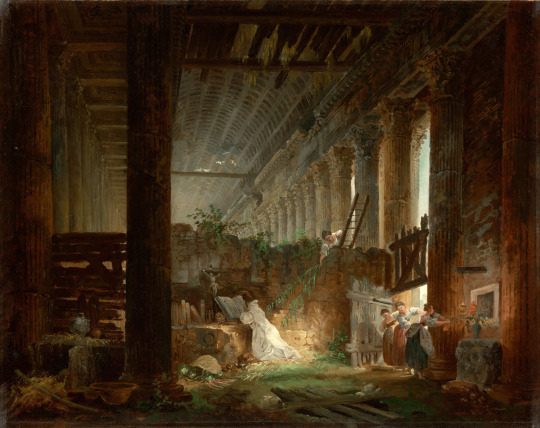
A Hermit Praying in the Ruins of a Roman Temple
Artist: Hubert Robert
Year: about 1760
Medium: Oil on Canvas
Dimension: 57.8 × 70.5 cm
Location: Getty Museum, Los Angeles
“We have a very low-key image, dark, but with enough light to convey information, story, and details of the location. The subject is pretty clearly the hermit in white, but Robert has given us secondary and tertiary reads from the 3 girls in the doorway, the one up on the ledge, and the personal effects in the left corner.”
“Compositionally, the image is cut by the pillar on the left, but the basin and jug in that corner keep it from feeling extraneous to the story. There is a VERY strong one-point perspective, and interestingly, there is no payoff at the vanishing point, which would be common in most paintings.”
“This entire painting is pretty loose, and the subject is no exception.
Things are more hinted at than tightly rendered.
His shadows are painted with the contour instead of across them and are almost all simply single strokes of paint.
In contrast, the highlights across the back of the form are painted as cross-contour strokes.”
“The other elements around the monk are equally or even more loose. I think we can safely say that while he is the "subject" of the painting, Robert wanted our eyes to take in the whole thing, so he didn't over detail this part to keep us focused on it.”
“Interestingly, although they lack the contrast of the monk, the secondary-read characters are more detailed. I would say that they are more important to the story of the painting, and Robert may also be relying on the fact that a pretty girl tends to capture people's attention!”
“Either way, they too are given the same shadow and highlight treatment as the monk.”
“Although he's placed another figure with a story element here, the primary focus, in my opinion, is the architecture. This is Robert's chance to show the ruins he loved. Check out the details and method of abstraction on those columns! Look how he is introducing variations in color and value to sell the "ruined" aspect of the temple.”
“Again, very low contrast but fairly tight detail. He's once more telling us that this secondary information is fun to discover, and putting it on the left side of the column makes it feel like a secret to be found. The stick curves back up to the far left column, which leads back to the roof and the crossbars that take us back into the painting.”
“Finally, the background of the image. Observe how he lessens detail and contrast as things recede. The birds and the green leaves exist to give a sense of scale and depth, and a final fourth read of interest. Everything is very abstract at this point in the painting.”
“Learnings:
Design your light and dark with a definite point of view. Don't keep them balanced, make one "stronger" in the image than the other.
You can vary contrast, detail, and placement to keep secondary and tertiary elements interesting. Not every painting has to have all of these things decrease uniformly, it is possible to have high contrast, looser subject, and more detailed, less contrasty secondary reads.
If you divide your canvas, make sure you have some sort of payoff in all sections.”
- Sethrutledge.com
#artist#french artist#art history#art history class#art history with Mihoki#hubert robert#capriccio#landscape#ruins#xviii century#enlightenment#oil on canvas#temple
1 note
·
View note
Text
Joseph Vernet (1714-1789)
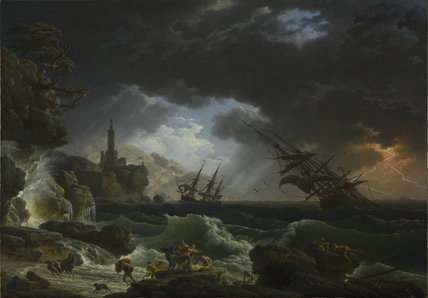
A Shipwreck in Stormy Seas - 1773
Claude-Joseph Vernet was the leading French landscape painter (with Hubert Robert) of the later 18th century.
He achieved great celebrity with his topographical paintings (description of the physical features, both geographical and man-made) and serene landscapes. He was also one of the century's most accomplished painters of tempests and moonlight scenes. Vernet was born at Avignon and trained there with his father, Antoine, and with the history painter Philippe Sauvan. He spent the years 1734 to 1752 in Rome, where he studied classical landscapes in the tradition of Claude and Gaspard Dughet, as well as the dramatic paintings of Salvator Rosa.
In Rome, he was influenced by the contemporary Roman topographical painter Giovanni Paolo Panini. He had many English clients and admirers in Rome, including Richard Wilson, whom Vernet is thought to have encouraged as a landscape painter. Vernet became a member of the Academy on his return to France and in 1753 received the important royal commission for a series of large canvases representing the ports of France (1753-65).
- The National Gallery
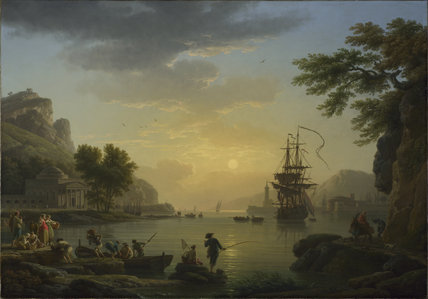
A Landscape at Sunset
Artist: Claude-Joseph Vernet
Year: 1773
Medium: Oil on canvas
Dimensions: 114.5 x 163.5
Location: The National Gallery, London (Not on display)
'A Landscape at Sunset' shows a port bathed in glowing evening sunshine. The mood is one of serenity, yet the painting is full of details of activities and the effects of light are rendered with breathtaking delicacy. Vernet was renowned for pairs of paintings showing contrasting states of nature and his works were especially sought-after by British collectors in the 18th-century. This painting and its pendant, 'A Shipwreck in Stormy Seas' are now the only such pair to be found in a British public collection. The pair originally belonged to the celebrated Englishman Clive of India, who bought them from Vernet in 1773. They are acknowledged as being two of Vernet's greatest marine pictures.
- The National Gallery
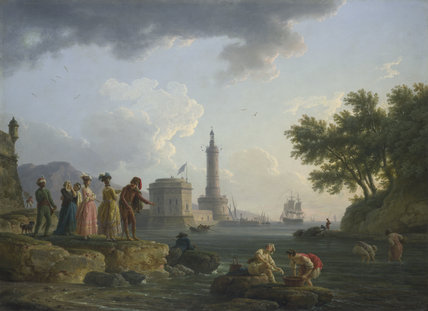
A Sea-Shore
Artist: Claude-Joseph Vernet
Year: 1776
Medium: Oil on copper
Dimensions: 62.2 x 85.1 cm
Location: The National Gallery, London
This painting is recorded as having been made as one of a pair for the Comte de Luc. The scene is largely fanciful but includes reminiscences of real buildings, notably the Naples lighthouse, recorded by Vernet in a drawing in Vienna.
The washerwomen by the river to the right are observed by the fashionably dressed ladies on a platform of rock on the left. The latter have with them a black page and a man in a military costume who gestures across to the river. This group, balanced in the composition by the trees to the right, is silhouetted against the sun and overshadowed by the dark cloud that stretches over the lighthouse on the central axis of the painting. This Italian coastal scene bathed in soft sunlight is clearly influenced by the port scenes of Claude, though much of the effect in Vernet's painting depends upon its picturesque human detail.
- The National Gallery
#art history#artist#french artist#landscape#sublime#shore#sea#tempest#art history with Mihoki#art history class#claude joseph vernet#vernet#french art#xviii century#oil on copper#the national gallery
1 note
·
View note
Text
Discovery of the Sublime
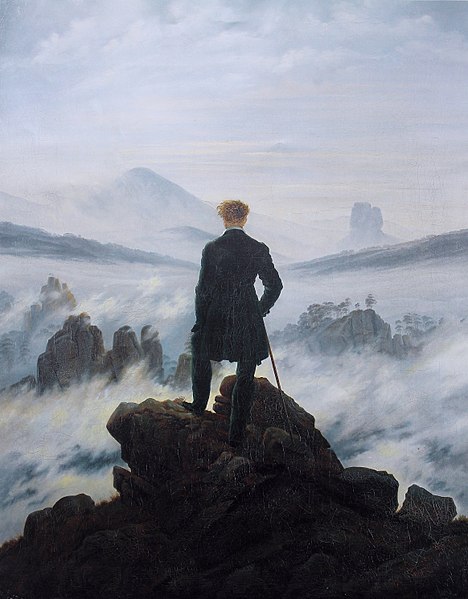
Caspar David Friedrich, Wanderer above the Sea of Fog, 1817
Romantic artists during the 19th century used the epic of nature as an expression of the sublime
In aesthetics, the sublime is the quality of greatness, whether physical, moral, intellectual, metaphysical, aesthetic, spiritual, or artistic.
The term especially refers to greatness beyond all possibility of calculation, measurement, or imitation
- Wikipedia
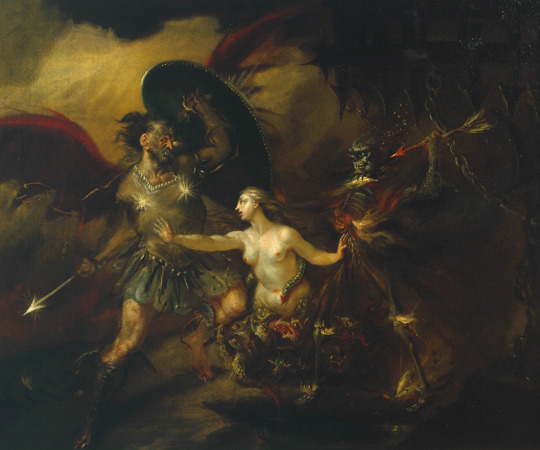
William HogarthSatan, Sin and Death, 1735–40
The sublime has long been understood to mean a quality of greatness or grandeur that inspires awe and wonder.
From the seventeenth century onwards the concept and the emotions it inspires have been a source of inspiration for artists and writers, particularly in relation to the natural landscape.
The sublime in art, it has often been suggested, start with Edmund Burke’s Philosophical Enquiry (1757).
Before this, so the conventional narrative goes, the sublime was a notion that applied only to rhetoric. However, the sublime in this period was very much concerned with the potential power of style and composition in the visual arts as much as in language, though it had yet to be applied to nature.
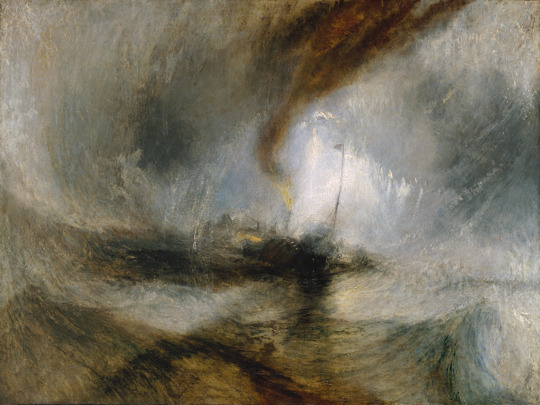
Turner, Snow Storm - Steam-Boat off a Harbour's Mouth, 1842
Edmund Burke’s Philosophical Enquiry (1757) connected the sublime with experiences of awe, terror, and danger.
Burke saw nature as the most sublime object, capable of generating the strongest sensations in its beholders. This Romantic conception of the sublime proved influential for several generations of artists.
- Tate.org
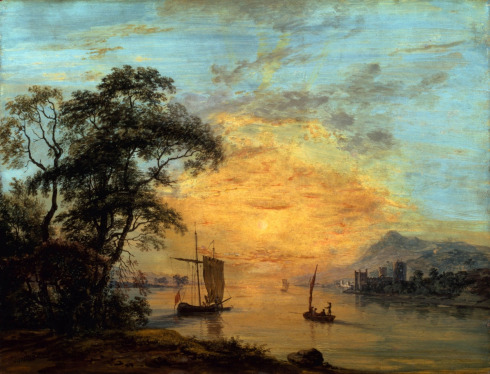
Paul Sandby, A Welsh Sunset River Landscape, 1775-1800
The sensualist materialism of the century of the French Revolution is not limited to the pursuit of pleasure. One wonders about the forces that animate men, about the causes of their desires, and the origin of their feelings. This corresponds to a change of sensibility that affects the whole of European society and will be expressed through literature and the arts.
This sensitivity is described with the word "Sublime", which is revealed in the relationship that man establishes with nature.
Thus, from the end of the seventeenth century, nature appears as a spectacle, whereas formerly was scorned and ignored.
This paradoxical feeling that the sublime arouses finds its fullest expression in England in travel literature ("horrid prospect", "delightful horror", "a terrible joy"...)
To consider nature as a place of indomitable energy is to finally recognize the limits of the aesthetics of balance and open the way to the drive.
For men of the eighteenth, nature appears as an active force.
The discovery of the laws of universal gravitation contributes to destabilizing the clear and fixed geometric design of the Renaissance world.
The individual is confronted with the signs of a Time that exceeds him. The acting force is exerted in the thrust of the imaginary and the passion which make their way by jostling the simple faculties of the understanding.
By thus proposing a set of plastic forms that both coexist with the beautiful and oppose it, the artists show that the individual experiences contradictory affects.
It will return in the nineteenth century to explore the complexity of human feelings.
#art#art history#art history class#art history with Mihoki#sublime#litterature#aesthetic#nature#philosophy#english art#england#english litterature#baroque#romantic#landscape#xix century#xviii century#XVII century
3 notes
·
View notes
Text
Jean-Honoré Fragonard (1732-1806)
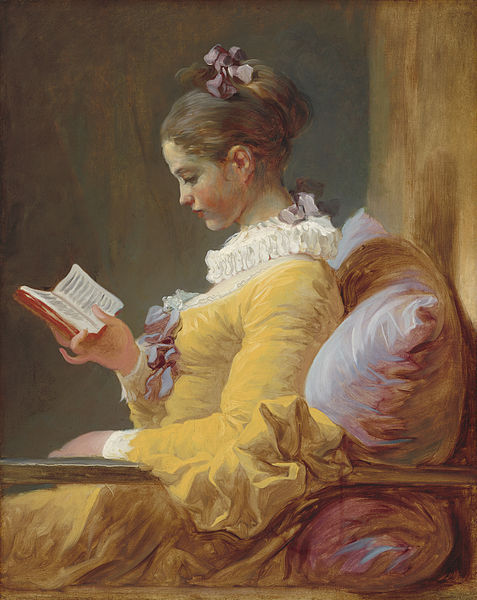
Young Girl Reading - 1776
Jean-Honoré Fragonard was a French painter and printmaker whose late Rococo manner was distinguished by remarkable facility, exuberance, and hedonism.
One of the most prolific artists active in the last decades of the Ancien Régime, Fragonard produced more than 550 paintings (not counting drawings and etchings), of which only five are dated. Among his most popular works are genre paintings conveying an atmosphere of intimacy and veiled eroticism.
- Wikipedia
The art of Fragonard expresses the vertigo of pleasure seized in the moment of entertainment.
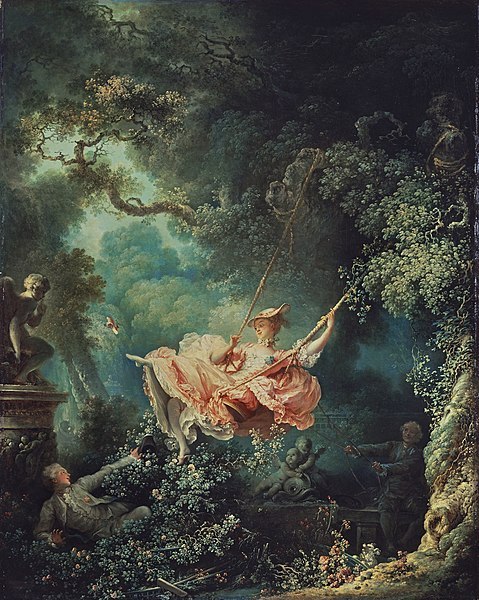
The Swing
Artist: Jean-Honoré Fragonard
Year: ca. 1767
Medium: Oil on canvas
Dimensions: 81 cm × 64.2 cm ( 31 7⁄8 in × 25 1⁄4 in)
Movement: Rococo
Location: Wallace Collection, London
The painting depicts an elegant young woman on a swing.
A smiling young man, hiding in the bushes on the left, watches her from a vantage point that allows him to see up into her billowing dress, where his arm is pointed with hat in hand.
A smiling older man, who is nearly hidden in the shadows on the right, propels the swing with a pair of ropes.
The older man appears to be unaware of the young man.
As the young lady swings high, she throws her left leg up, allowing her dainty shoe to fly through the air. The lady is wearing a bergère hat (shepherdess hat).
Two statues are present, one of a putto, who watches from above the young man on the left with its finger in front of its lips in a sign of silence, the other of pair of putti, who watch from beside the older man, on the right.
This style of "frivolous" painting soon became the target of the philosophers of the Enlightenment, who demanded a more serious art which would show the nobility of man.
- Wikipedia
Aesthetic of lightness: the lightness of the body in space, the slipper thrown as an offering, time reduced to the instantaneous.
The rapidity of the desire glimpsed to which response vegetation painted with vivacity.
The gap of the foundation allowing the movement of the swing redoubles the notch of the petticoats, while the comings and goings of the swing suggest an erotic movement.
If pleasure requires celerity, it is taken by stealth: kisses are stolen, oblique glances, bold gestures.
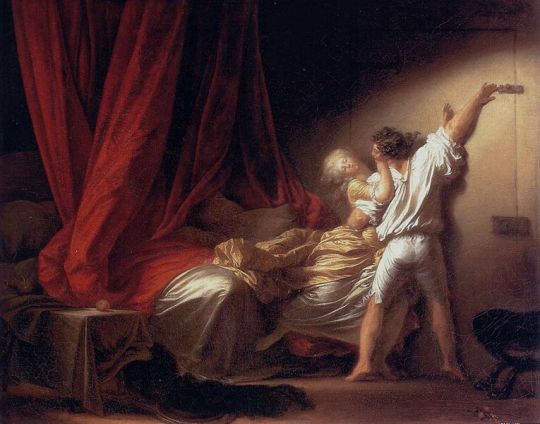
The Lock
Artist: Jean-Honoré Fragonard
Year: 1774-1778
Type: Peinture
Technique: Oil on canvas
Dimensions: (H × L)73 × 93 cm
Movement: Rococo
Location: Louvre Museum, Paris
In the Lock, a young man pulls the lock of the room to preserve his privacy while the girl tries to prevent it. The imposing presence of the bed seems to tell the continuation of the story, but in the disorder of the sheets does not correspond to the chronology: the act not being consumed yet, the alcove would be the metaphor of the female sex.
Just like Francis Boucher, Fragonard used a sublayer of printing red or gray, said "printer", like the colorful background and this before putting the paint. This sublayer allowed to avoid medium absorbing the paint.
After making the sketch of the subject by an outline, he applied the paint in several superimposed layers. The stroke was fine, light but precise, nervous and effective.
The stroke of Fragonard besides is easily recognizable by his spontaneity, his genius.
#art#artist#art history#art history class#art history with Mihoki#french artist#french painter#enlightment#rococo#XVII century#fragonard#jean honoré fragonard#louvre#pleasure#erotism#hedonism#oil on canvas
1 note
·
View note
Text
François Boucher (1703 - 1770)
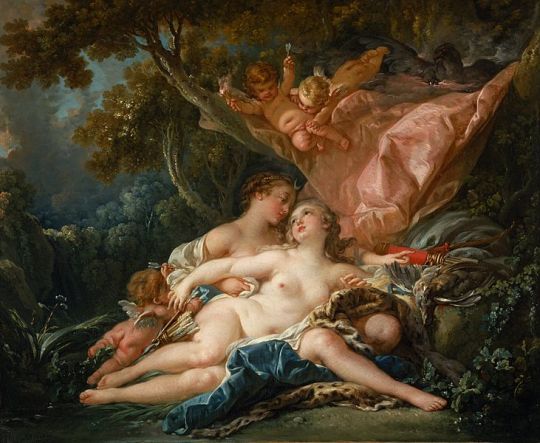
Diana and Callisto - 1759
François Boucher was a French painter, draughtsman, and etcher, who worked in the Rococo style.
Boucher is known for his idyllic and voluptuous paintings on classical themes, decorative allegories, and pastoral scenes. He was perhaps the most celebrated painter and decorative artist of the 18th century.
Pleasure is expressed in its most trivial form in the paintings of François Boucher known for his well-bred women showing in a ruffle of satin their curves.
The claim of sensual pleasure as an expression of natural morality, as opposed to devout morality, belongs to the eighteenth century.
Love conquest is defiant and debauchery is provocative of Christian law.
Availability for sexual adventures and strategies of seduction are a way to translate, in manners, the freedom of thought.
Freedom of thought that will be ejected from history by the Revolution. Still, the hedonistic state of mind strongly permeates the century of arts and especially the Rococo style.
This hedonistic will-to-live expresses itself in the immediacy and the moment: a moment of jouissance and consummated pleasure.
The expression of immediacy is thus one of the great principles of the libertines whose strategy of seduction is based on the military conquest: it is about "seizing the opportune moment".
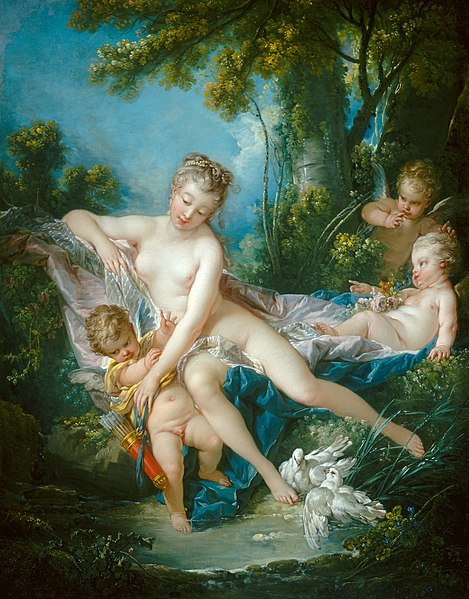
Venus Consoling Love
Artist: François Boucher
Year: 1751
Medium: Oil on canvas
Dimensions: 107 cm × 84.8 cm (42 in × 33.4 in)
Movement: Rococo
Location: National Gallery of Art, Washington, D.C.
The painting depicts a mythological scene, where Venus, the goddess of Love, depicted as a charming and supple young woman, is impersonating the French Rococo's beauty ideals.
She is about to disarm Cupid, by taking away his arrows, that he uses when shooting at people to make them fall in love.
Venus sits beside the pond with doves, the goddess symbol.
The white doves at her feet, her complexion, the pearls in her hair are just as luxurious like the silk draperies that were wrapped around her, but now are lying on the ground.
Boucher painted the artwork with soft pastel tones using a dim silvery light.
The painting was made with high technical skill.
The principal charm of Rococo art is its sensuality and seductivity.
The painting belonged to Mme de Pompadour, the French king's mistress, displayed at Château de Bellevue, who commissioned it, and it was Madame de Pompadour who allegedly posed for the painting. Artists liked to work for her not only for the prestige of working for the aristocracy but also because she paid her bills regularly. It has even been suggested that Boucher's young wife was the young woman posing for the figure of Venus, but it is more a soft and appealing essence of feminine beauty, that appears in front of us in the figure of the Venus painted by the French artist Boucher.
- Wikipedia
#art history#french artist#french painter#art history class#art history with Mihoki#oil on canvas#pastel colors#xviii century#rococo#enlightment#seduction#hedonism#mythology
24 notes
·
View notes
Text
Jean-Antoine Watteau (1684 - 1721)
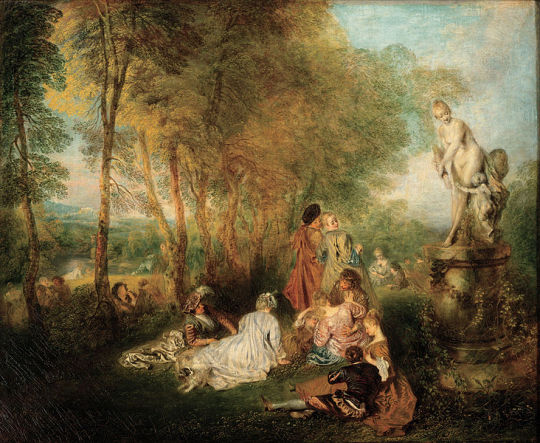
The Feast of Love - 1719
Antoine Watteau was a French painter whose brief career spurred the revival of interest in color and movement, as seen in the tradition of Correggio and Rubens.
He revitalized the waning Baroque style, shifting it to the less severe, more naturalistic, less formally classical, Rococo.
Watteau is credited with inventing the genre of fêtes galantes, scenes of bucolic and idyllic charm, suffused with a theatrical air.
Some of his best-known subjects were drawn from the world of Italian comedy and ballet.
- Wikipedia
A new perception of human psychology and the functioning of the body is emerging which places matter (and not the mind) at the base of development during the French movement Les Lumières. It is important to know the connection between this new vision of life and the body (hedonism) which gives to sensitive knowledge status of truth and artistic creation.
Jean Antoine Watteau expresses this overflow of spirit, of worldliness, of frivolity, but also of intelligence and pleasure of living.
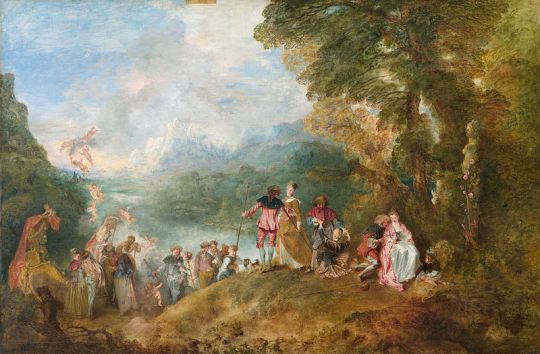
The Embarkation for Cythera
Artist: Jean Antoine Watteau
Year: 1717
Type: Fête Galante, Genre Art
Technique: Oil on Canvas
Dimensions: (H × L)129 × 194 cm
Movement: Rococo
Localization: Louvre Museum, Paris
In this painting, we see an assembly plagued by strange idleness. It is an evocation of an ephemeral world whose factitious aspect leaves point a certain melancholy. (Kythera was in Greek mythology, the island of all pleasures).
The painting inaugurates the genre “Fête Galante" created to name the art of Watteau: recreation, casualness, nonchalance, murmured confidences and tender confessions that characterize this genre whose particularity is to show no action.
Nothing happens and in this nothing, something already nostalgic slips.
“Fête Galante" is also for an amorous celebration or party enjoyed by the aristocracy of France during the Régence after the death of Louis XIV, which is generally seen as a period of dissipation and pleasure, and peace, after the sombre last years of the previous reign.
The work celebrates love, with many cupids flying around the couples and pushing them closer together, as well as the statue of Venus (the goddess of sexual love).
There are three pairs of lovers in the foreground. While the couple on the right by the statue are still engaged in their passionate tryst, another couple rises to follow the third pair down the hill, although the woman of the third pair glances back fondly at the goddess’s sacred grove.
At the foot of the hill, several more happy couples are preparing to board the golden boat at the left.
With its light and wispy brushstrokes, the hazy landscape in the background does not give to any clues about the season, or whether it is dawn or dusk.
It has often been noted that, despite the title, the people on the island seem to be leaving rather than arriving, especially since they have already paired up.
Many art historians have come up with a variety of interpretations of the allegory of the voyage to the island of love. Watteau himself purposely did not give an answer.
- Wikipedia
#jean antoine watteau#antoine watteau#watteau#art#art history#art history class#art history with Mihoki#rococo#baroque#xviii century#french artist#french painter#mythology#oil painting#oil on canvas#genre art
11 notes
·
View notes
Text
Jean Siméon Chardin (1699 - 1779)
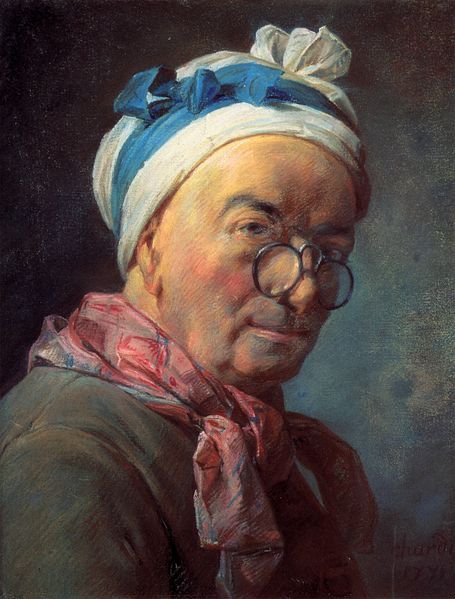
Self-portrait - 1771
Chardin was an 18th-century French painter.
He is considered a master of still life, and is also noted for his genre paintings which depict kitchen maids, children, and domestic activities.
Carefully balanced composition, soft diffusion of light, and granular impasto characterize his work.
Chardin's work had little in common with the Rococo painting that dominated French art in the 18th century. At a time when history painting was considered the supreme classification for public art, Chardin's subjects of choice were viewed as minor categories.
He favored simple yet beautifully textured still lifes, and sensitively handled domestic interiors and genre paintings. Simple, even stark, paintings of common household items (Still Life with a Smoker's Box) and an uncanny ability to portray children's innocence in an unsentimental manner (Boy with a Top [right]) nevertheless found an appreciative audience in his time, and account for his timeless appeal.
Largely self-taught, Chardin was greatly influenced by the realism and subject matter of the 17th-century Low Country masters. Despite his unconventional portrayal of the ascendant bourgeoisie, early support came from patrons in the French aristocracy, including Louis XV.
- Wikipedia
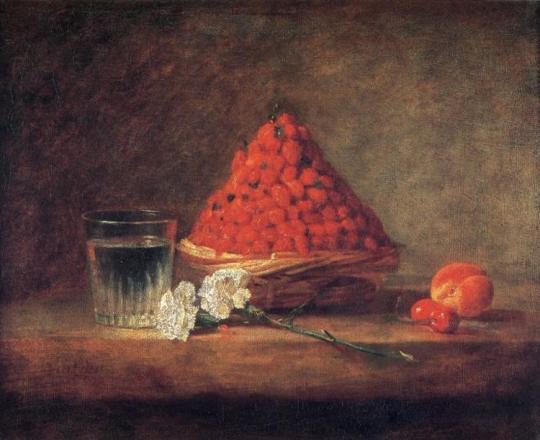
Basket of Wild Strawberries
Artist: Jean Siméon Chardin
Year: 1761
Type: Still Life
Medium: Oil on canvas
Dimensions: 38 × 46 cm
Location: Private collection, Paris
In still life painting, there is an attachment to the concrete reality of things that requires the object to be viewed for what it is to know, a form and a material.
The term that defines the physical aspect of the matter is substance.
Chardin thus paints the infinite variations of substances. He wants to express the sensible thickness of things. Transparent objects are the perfect example since the eye can cross it. (Hence the frequent presence of the glass used as the zero degrees of the object which becomes opaque according to its physical qualities.)
In the basket of strawberries, a glass counterpoint to the red pyramid in the greatest simplicity. Simplicity by which Chardin rejects the Rococo style in which the bourgeoisie is recognized.
Chardin neutralizes the space around objects: the background appears uniform, without depth or effect of perspective. His painting also solicits other senses such as touch and taste.
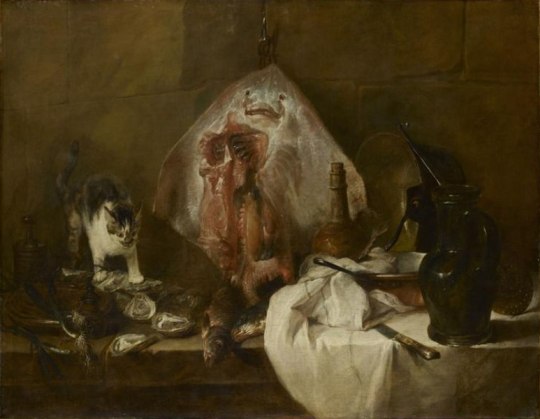
The Ray
Artist: Jean Siméon Chardin
Year: 1728
Type: Oil on canvas
Dimensions: (H × L)114 × 146 cm
Movements: Naturalism, rococo
Localization: Louvre Museum, Paris
The painting is divided vertically into two parts:
the living on the left (cat, oysters)
the inanimate on the right (pitcher, pot and other utensils),
the line making the transition between these two parts.
The composition of the table is made of interlocking pyramids. The line forms the first great pyramid, while the cat, on the one hand, the utensils, on the other hand, form two small pyramids imbricated in the big one.
A vertical outgoing angle appears on the wall, in contradiction with the foreground. The handle of the knife hanging on the edge of the table seems to leave the table. These details give a great depth to the composition.
The spiked cat, the reflections on the utensils, the bloody streak are all "flashes" that catch the eye and give rhythm to the table.
This painting offers a wide range of material corresponding to the multiple objects in the presence. The singularity of the painting lies especially in the astonishing exposure of the eviscerated ray.
By its frightening and unconventional aspect, the fish has aroused many interpretations:
the line would return to crucifixion by its diamond shape and nails
It would be a metaphor of the painting by its planarity which redoubles the wall on which it is hung
It would represent the feminine sex by getting a vertical injury
We can see in this inflation interpretations, even overinterpretation, the expression of the discourse on the art of the 70s.
#art history#art#art history class#art history with Mihoki#french artist#french painter#oil painting#oil on canvas#xviii century#still life#self portrait#pastel#simplicity#chardin#jean simeon chardin#louvre#vanitas
8 notes
·
View notes
Text
Rembrandt (1606 - 1669)
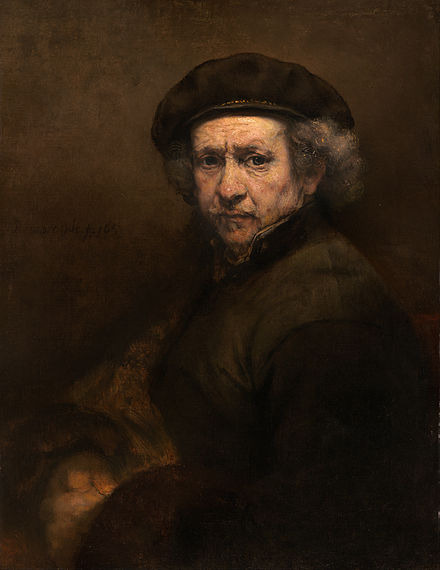
Self-portrait with Beret and Turned-Up Collar - 1659
Rembrandt was a Dutch draughtsman, painter, and printmaker.
He is generally considered one of the greatest visual artists in the history of art and the most important in Dutch art history. Unlike most Dutch masters of the 17th century, Rembrandt's works depict a wide range of style and subject matter, from portraits and self-portraits to landscapes, genre scenes, allegorical and historical scenes, biblical and mythological themes as well as animal studies.
His contributions to art came in a period of great wealth and cultural achievement that historians call the Dutch Golden Age, when Dutch art (especially Dutch painting), although in many ways antithetical to the Baroque style that dominated Europe, was extremely prolific and innovative and gave rise to important new genres.
Rembrandt never went abroad, but unlike Vermeer, he was considerably influenced by the work of the Italian masters and Netherlandish artists who had studied in Italy, like Pieter Lastman, the Utrecht Caravaggists, and Flemish Baroque Peter Paul Rubens.
In his works he exhibited knowledge of classical iconography, which he molded to fit the requirements of his own experience; thus, the depiction of a biblical scene was informed by Rembrandt's knowledge of the specific text, his assimilation of classical composition, and his observations of Amsterdam's Jewish population. Because of his empathy for the human condition, he has been called "one of the great prophets of civilization".
- Wikipedia
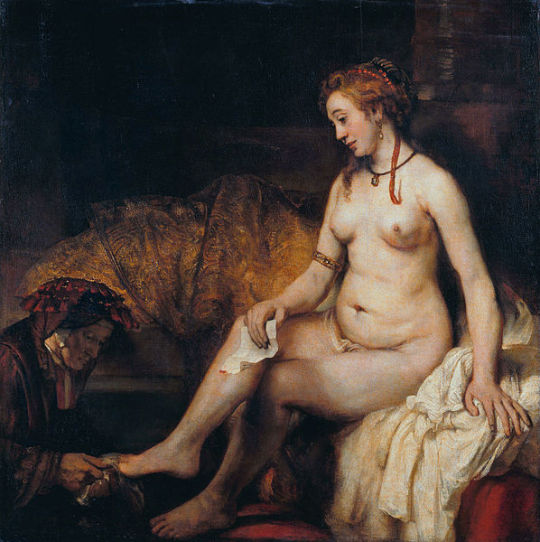
Bathsheba at Her Bath
Artist: Rembrandt
Year: 1654
Medium: Oil on canvas
Dimensions: 142 cm × 142 cm (56 in × 56 in)
Location: The Louvre, Paris
The use of light symbolizes subjectivity, feelings, thoughts, consciousness (= interiority) This conception refers to two models:
religious (Judaism, which forbids representation of God)
profane (philosopher turned to reflection)
These two models share the same devotion to the book,
the book as the opposite of the image
reading as the opposite of the vision.
Unlike other Dutch paintings, texts are here illegible. As if, thanks to this illegibility, the artist avoided the confusion between the reading and the image. Rembrandt insists that what is precious is the Word, the one in the text and not its superficial appearance.
Unlike Caravaggio, where the light comes from outside the scene, here it comes from beings. It is the individual, the subject who is the light source. By painting the light emerging from the darkness, he shows the transmutation of matter into a spiritual element.
In Bathsheba, we see a thoughtful woman coming to read a love letter. However, Rembrandt rejects the epistolary surface to emphasize the interiority. The scenery of the stage is dark. Rembrandt does not attach himself to external elements.
Apart from the lack of anecdotal devices, the painting is unusual in other ways. Bathsheba is presented in a space that is difficult to read. The dark background is suggestive of night, while a massive column implies a large architectural structure. Behind her lies a passage of richly painted drapery composed of browns and ochers that impart a golden warmth. Around her rests a thickly painted background of white chemise; set against this her naked flesh stands out for its solid form and the sumptuous application of paint.
The paint used to describe her figure is richly nuanced, its broad brushstrokes and strong highlights impart a vibrant tactile quality to the body, rendering her presence palpable.
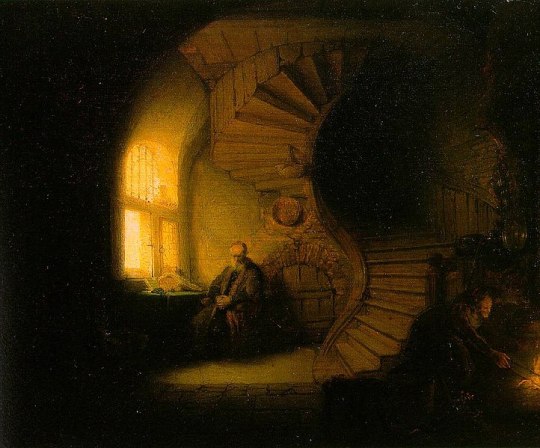
Philosopher in Meditation
Artist: Rembrandt
Year: 1632
Type: Genre Art
Medium: Oil on canvas
Dimensions: (H × L)28 × 34 cm
Location: The Louvre, Paris
In Vermeer’s paintings, the source of light often comes from the window, whereas here it is not assignable, it ceases to be a pure physical element. (here, we see that its function is not to illuminate the scene but to transfigure it to make an interior vision.)
The architecture includes stone, brick, and wood, with arched elements (window, vault, doors) that create an impression of monumentality.
On the pre-iconographic level, this is one of the most "graphic" works painted by Rembrandt, in the sense that it contains many straight, curved, circular, and radiating lines: from the lines of the flagstones to those of the window, the bricks, the wainscotting, and of course the staircase.
As in the staircase and the basketwork tray at the center of the composition, the curved lines can be said to organize the straight lines.
The first figure is that of an old man seated at a table in front of a window, his head bowed and his hands folded in his lap. The second figure is that of an old woman tending a fire in an open hearth. A third figure—a woman standing in the stairs carrying a basket and turned to the spectator—is visible in 18th- and 19th-century engraved reproductions of the painting, but virtually invisible in the painting's present state.
As it is, the overall painting is quite dark due to the aging of the varnish.
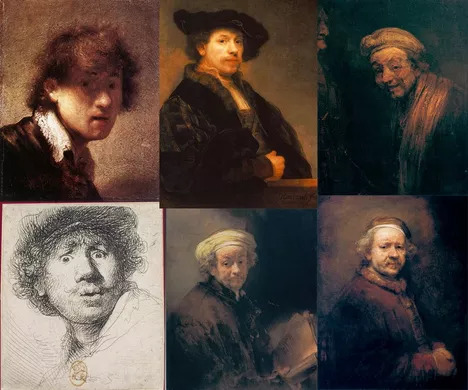
The 62 self-portraits he painted, testify to an affirmation of life as the deployment of time.
The appearance of the face out of the shadows, its outcrop on the surface, indulges in time. Not in the moment immobile and suspended like Vermeer's, but in a dynamic way: the face of the artist unfolding in the flow of life.
Rembrandt strives to make the deployment of time visible and sensitive.
#rembrandt#dutchart#oil painting#painting#dutch#dutch golden age#XVI century#art#art history class#art history with Mihoki#art history#meditation#self portrait#book#mythology#religion#painter
2 notes
·
View notes
Text
Jan Vermeer (1632 - 1665)
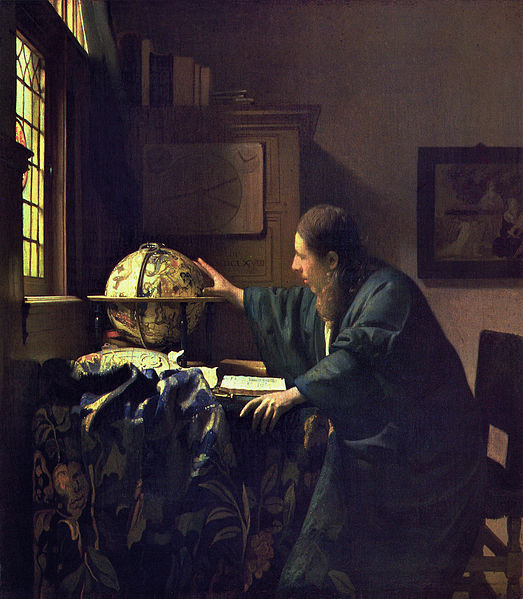
The Astronomer - 1668
In contrast to the great mythological or biblical subjects, the painting of the Netherlands shows everyday life, its sets, its objects, and its familiar gestures. Among many other painters include Ter Borch, Peter Hooch, Franz Hals, and Vermeer.
Johannes Vermeer was a Dutch painter who specialized in domestic interior scenes of middle-class life. He was a moderately successful provincial genre painter in his lifetime but evidently was not wealthy, leaving his wife and children in debt at his death, perhaps because he produced relatively few paintings.
Vermeer worked slowly and with great care, and frequently used very expensive pigments. He is particularly renowned for his masterly treatment and use of light in his work.
Vermeer painted mostly domestic interior scenes. "Almost all his paintings are apparently set in two smallish rooms in his house in Delft; they show the same furniture and decorations in various arrangements and they often portray the same people, mostly women."
He was recognized during his lifetime in Delft and The Hague, but his modest celebrity gave way to obscurity after his death. In the 19th century, Vermeer was rediscovered by Gustav Friedrich Waagen and Théophile Thoré-Bürger, who published an essay attributing 66 pictures to him, although only 34 paintings are universally attributed to him today.
Since that time, Vermeer's reputation has grown, and he is now acknowledged as one of the greatest painters of the Dutch Golden Age. Like some major Dutch Golden Age artists such as Frans Hals and Rembrandt, Vermeer never went abroad. And like Rembrandt, he was an avid art collector and dealer.
- Wikipedia
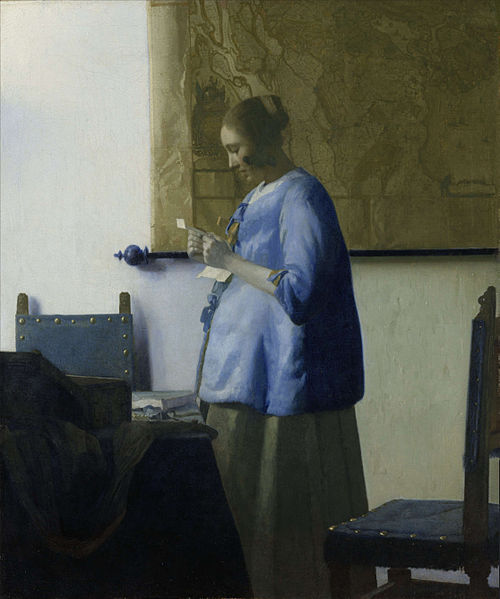
Woman in Blue Reading a Letter
Artist: Johannes Vermeer
Year: 1663–1664
Medium: Oil on canvas
Dimensions: 46.6 cm × 39.1 cm (18.3 in × 15.4 in)
Location: Rijksmuseum Amsterdam, Amsterdam
The central element of the painting is a woman in blue standing in front of a window (not depicted) reading a letter.
The woman appears to be pregnant, although many have argued that the woman's rounded figure is simply a result of the fashions of the day. Although the woman's loose clothing may be suggestive, pregnancy was very rarely depicted in art during this period.
While the contents of the letter are not depicted, the composition of the painting is revealing. The map of the Netherlands on the wall behind the woman has been interpreted as suggesting that the letter she reads was written by a traveling husband.
Alternatively, the box of pearls barely visible on the table before the woman might suggest a lover as pearls are sometimes a symbol of vanity.
The very act of letter-reading reflects a thematic pattern throughout Vermeer's works, as the quotidian, private moment becomes revealing of the human condition.
The painting is unique among Vermeer's interiors in that no fragment of corner, wall or ceiling can be seen.
- Wikipedia
Vermeer's painting is remarkable for the quality of the look she seeks from the viewer. The meticulousness of the representation would call for visual attention which leads to review each element of the painting, to detail them by exploring the visible surface of things.
The woman in blue reading a letter shows that the painter remains faithful to the presence of the letter as a text that absorbs the attention of the reader while remaining inaccessible. The reader thinks she is alone, absorbed in her reading. The act requires attention, a stop of time. (time suspended)
Affectivity spreads and defines a space of intimacy, mixing the physical with the spiritual, the thought and the body.
Vermeer makes perceptible the relationship of continuity that exists between the woman and her immediate space as if her surroundings were an extension of her being. The delicacy of the treatment of light reflects the impregnation of reality from an irradiating focus. The visible is very homogeneous, while the detail looked at isolation refracts the whole.
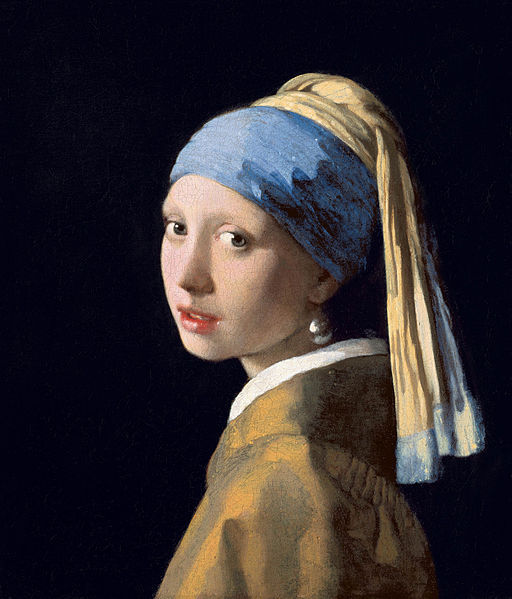
Girl With a Pearl Earring
Artist: Johannes Vermeer
Year: c. 1665
Type: Tronie
Medium: Oil on canvas
Dimensions: 44.5 cm × 39 cm (17.5 in × 15 in)
Location: Mauritshuis, The Hague, Netherlands
Composition
The composition of Girl with a Pearl Earring is delightfully simple. Unlike most of the other paintings by the Delft master, the subject here is only a simple head of a girl looking over her shoulder at the viewer. No hint of a setting is provided, other than its atmospherically dark tone. This too is unusual for the mature Vermeer.
The unusually direct contact between subject and spectator, and the slightly parted position of the lips, presents a sense of immediacy so great as to imply significant intimacy.
The girl is wearing a simple brownish-yellow top, which contrasts strongly with her bright white collar.
A further contrast is offered by her blue and yellow or turban (or chaperon) which gives the picture a distinctly exotic effect. Turbans were a relatively common accessory in Europe from the 15th century, as is shown by Man in a Red Turban (1433, National Gallery, London), the famous self-portrait by Jan Van Eyck.
Indeed, Vermeer's older contemporary, Rembrandt, painted single figures and heads in exotic costume throughout his life, and that similar small heads with unusual headgear by Carel Fabritius (1622-54) - who taught Vermeer - indicate that he may have carried this tradition to Delft.
The Meaning of the Girl with a Pearl Earring
The final but most noticeable feature of this picture is the girl's enormous, tear-shaped pearl earring. A similar item of jewelry can be seen in A Woman Brought a Letter by a Maid (aka Lady with Her Maidservant) (c.1667, Frick Collection, New York). This pearl earring, possibly along with the girl's turban, may unlock the meaning of the painting.
De Sales wrote that women should protect their ears from unclean words and that they should allow them to hear only chaste words - the "oriental pearls of the gospel."
Using this text as a reference, it seems that the pearl earring in Vermeer's painting represents chastity, while the "oriental" element mentioned is illustrated by the girl's turban.
Vermeer's Painting Methods: Camera Obscura
X-rays of this canvas have provided surprising information about Vermeer's painting methods. In most examples of 17th-Century Dutch painting, the under-painting reveals adjustments and corrections of edges, shapes, and forms. Here, however, rather than the tentative building up of elements, we find only a sharp pattern of light and dark.
This is all the more unusual since there is no sign of either line or a preliminary drawing to guide the master to this perfection.
Such an unusual procedure once again provides clear evidence in support of Vermeer's use of the camera obscura.
Indeed, one art critic has suggested that the sharply contrasting patterns of light and dark may be Vermeer's direct transcription of the incidence of light as viewed through his camera obscura.
If this is so, it would begin to account for the almost photographic directness apparent in this unusually naturalistic work.
- Visual Arts Cork
The pearl is a drop of light, become substance and surface. In the girl with the pearl, she is in counterpoint. The detail (pearl, earring) expresses the intimacy hidden beneath appearances, hence our indiscreet look.
#art history class#art#art history#artist#dutch#vermeer#jan vermeer#oil painting#xvii century#pearl#family#life#realism#oil on canvas#baroque
2 notes
·
View notes
Text
Diego Velázquez (1599 - 1660)
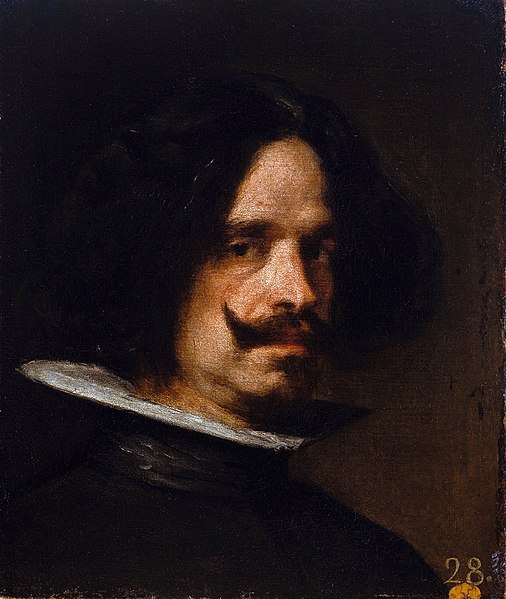
Self-portrait - 1650
Diego Velázquez was a Spanish painter, the leading artist in the court of King Philip IV, and one of the most important painters of the Spanish Golden Age.
He was an individualistic artist of the contemporary Baroque period. In addition to numerous renditions of scenes of historical and cultural significance, he painted scores of portraits of the Spanish royal family, other notable European figures, and commoners, culminating in the production of his masterpiece Las Meninas (1656).
From the first quarter of the nineteenth century, Velázquez's artwork was a model for the realist and impressionist painters, in particular, Édouard Manet.
Since that time, famous modern artists, including Pablo Picasso, Salvador Dalí and Francis Bacon, have paid tribute to Velázquez by recreating several of his most famous works.
- Wikipedia
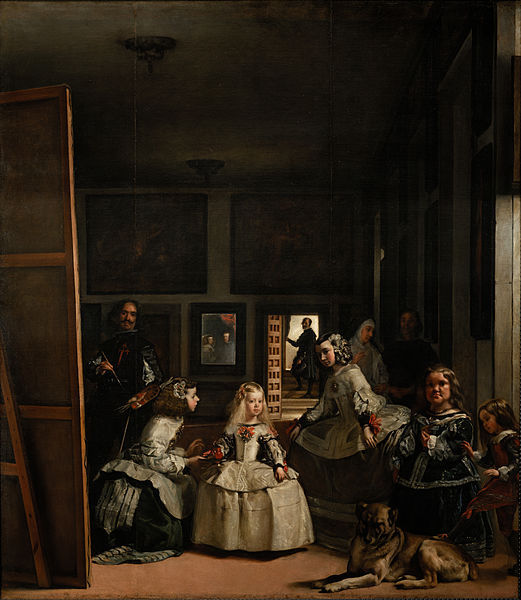
Las Meninas
Artist: Diego Velázquez
Year: 1656
Medium: Oil on canvas
Dimensions: 318 cm × 276 cm (125.2 in × 108.7 in)
Location: Museo del Prado, Madrid
The device put in place by the painter is vertiginous: in a room occupied by several characters including the Infanta and her maids of honor, chaperone, bodyguard, two dwarfs and a dog, the artist is painting the invisible royal couple (taking the place of the spectator) but reflecting in the mirror.
By staging the act of painting, the painting in the painting and the mirror, Velasquez dramatically focuses the discourses on painting and representation. (Reminding Van Eyck's painting, The Arnolfini Spouses)
Las Meninas has long been recognized as one of the most important paintings in Western art history. The Baroque painter Luca Giordano said that it represents the "theology of painting" and in 1827 the president of the Royal Academy of Arts Sir Thomas Lawrence described the work in a letter to his successor David Wilkie as "the true philosophy of the art".
More recently, it has been described as "Velázquez's supreme achievement, a highly self-conscious, calculated demonstration of what painting could achieve, and perhaps the most searching comment ever made on the possibilities of the easel painting"
- Wikipedia
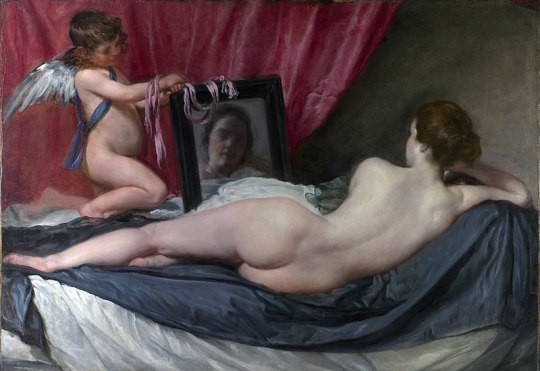
Rokeby Venus
Artist: Diego Velázquez
Year: 1649
Medium: Oil on canvas
Dimensions: 122cm x 177cm
Location: National Gallery, London
Velázquez combined two established poses for Venus: recumbent on a couch or a bed and gazing at a mirror.
She is often described as looking at herself on the mirror, although this is physically impossible since viewers can see her face reflected in their direction. This phenomenon is known as the Venus effect. In a number of ways the painting represents a pictorial departure, through its central use of a mirror, and because it shows the body of Venus turned away from the observer of the painting.
- Wikipedia
One of the rare Spanish nudes, where it induces a complex triangular relationship that involves the female body, his face, and desire of the spectator.
At this height of painting that constitutes the image reflected in the mirror meets the virtuosity of his touch: The sovereignty of the brush depositing its powdery, fast, slightly ironic way, resulting in extraordinary portraits and arousing the admiration of the painters themselves.
#art#artist#art history#art history class#art history with Mihoki#Spanish painter#Diego velazquez#Velazquez#Velasquez#Diego Velasquez#Las meninas#Venus#Mythology#Self portrait#Baroque#Portrait#xvii century
0 notes
Text
Nicolas Poussin (1594 - 1665)
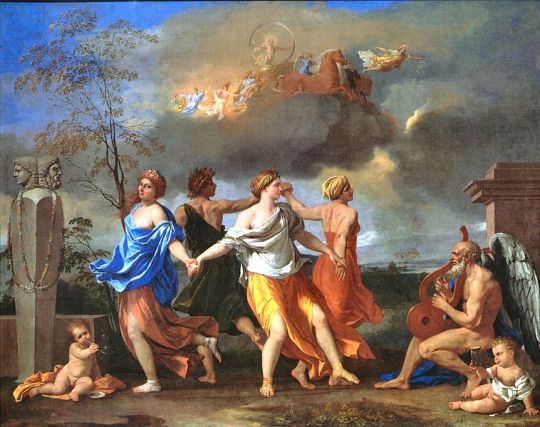
The Dance to the music of time - 1640
Nicolas Poussin was the leading painter of the classical French Baroque style, although he spent most of his working life in Rome.
Most of his works were on religious and mythological subjects painted for a small group of Italian and French collectors. He returned to Paris for a brief period to serve as First Painter to the King under Louis XIII and Cardinal Richelieu, but soon returned to Rome and resumed his more traditional themes.
In his later years, he gave growing prominence to the landscapes in his pictures. His work is characterized by clarity, logic, and order, and favors line over color.
Until the 20th century, he remained a major inspiration for such classically oriented artists as Jacques-Louis David, Jean-Auguste-Dominique Ingres, and Paul Cézanne.
- Wikipedia
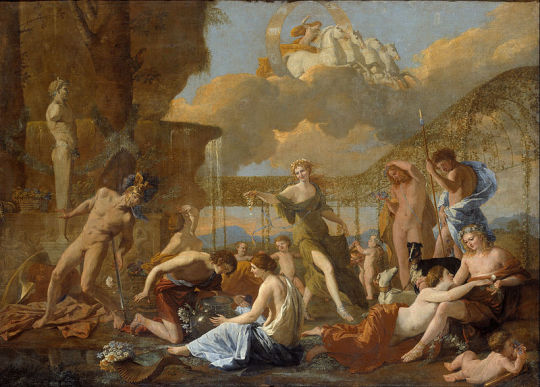
The Empire of Flora - 1631
Painting characters in action in exceptional (noble) circumstances through an idealized vision. (= principle of the painting of History).
For him, the 3 qualities required for the expression of beauty are the order, the mode, and the form.
Poussin considers painting as a geometric mental projection, as opposed to the physical space of sensation, the emergence of the phenomena of the expressive space of Caravaggio.
The paintings of Poussins are the fruits of meditation and composition long reflect. Hence the harmony and serenity of his art.
The balance of the painting is distributed over the internal relations between human figures, landscape, and architecture.
The drape that envelops the body helps to express these ideas: timeless and harmony of color related to the movement.
Gestural rhetoric: the most violent movements are fixed, stopped in their tracks: its model is not the living body but that of the statuary ideal.
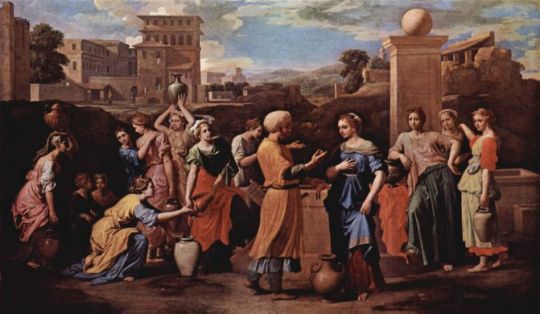
Eliezer and Rebecca - 1648
In the style of Greek and Roman art. The scene is arranged as in a long frieze inspired by ancient sarcophagi.
The two main characters are detached from the group and stand out in the foreground; the rest of the picture is made up of groups of young women, enabling Poussin to show off his great inventiveness through the variety of poses and expressions he gives to them.
Many of these are inspired by his study of ancient reliefs.
The balanced harmony of the composition is also due to a skillful blend of warm and cool colors, which distinguish the characters and make them stand out against the calm, imposing landscape of the background.
This, in turn, is given extra life by the classically inspired architecture.
- Musée du Louvre
Thus, the ideological stake of the pre-eminence of the hard text image, of the narrative on the visual, of the literature on painting, consists in the affirmation of the superiority of reason over the sensible, of the mind over the sensual, speech over pleasure.
In Poussin's art, drawing is a priority, (ie the structure of space, the composition and the outline of the figures).
The color is secondary, it has never been confused with shadow.
Poussin does not use the aerial perspective, unlike Leonardo da Vinci. Only the shrinking figures.
#art#art history#artist#art history class#art history with Mihoki#Poussin#Nicolas poussin#xvii century#french artist#Roma#Mythology#Religion#Painting#baroque
1 note
·
View note
Text
Parmigianino (1503 - 1540)
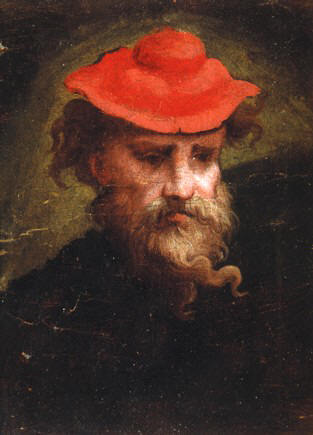
Self-portrait - 1540
Parmigianino was an Italian Mannerist painter and printmaker active in Florence, Rome, Bologna, and his native city of Parma.
His work is characterized by a "refined sensuality" and often elongation of forms and includes Vision of Saint Jerome (1527) and the iconic if somewhat untypical Madonna with the Long Neck (1534), and he remains the best-known artist of the first generation whose whole careers fall into the Mannerist period.
His prodigious and individual talent has always been recognized, but his career was disrupted by war, especially the Sack of Rome in 1527, three years after he moved there, and then ended by his death at only 37.
He produced outstanding drawings and was one of the first Italian painters to experiment with printmaking himself. While his portable works have always been keenly collected and are now in major museums in Italy and around the world, his two large projects in fresco are in a church in Parma and a palace in a small town nearby.
This in conjunction with their lack of large main subjects has resulted in their being less well known than other works by similar artists. He painted a number of important portraits, leading a trend in Italy towards the three-quarters or full-length figure, previously mostly reserved for royalty.
- Wikipedia
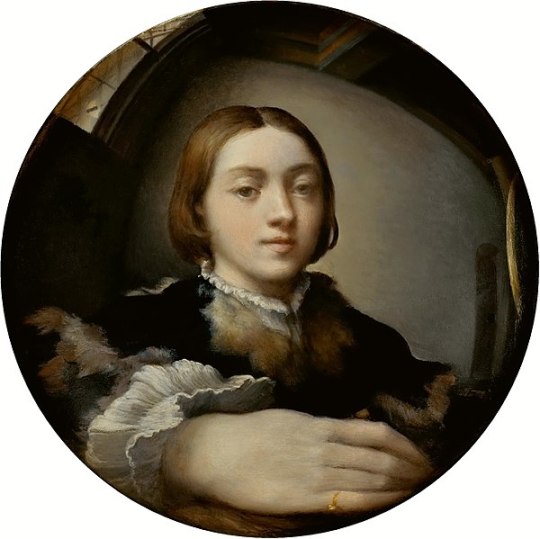
Self-portrait in a Convex Mirror
Artist: Parmigianino
Year: c. 1524
Type: Oil on convex panel
Dimensions: 24.4 cm diameter (9.6 in)
Location: Kunsthistorisches Museum
The work offered by the artist to Pope Clement VII will be found in Prague in the collection of Rodolphe II, a great lover of games of illusion.
Painted on a circular piece of wood, it is as much an object of curiosityas a painting.
Emblematic of Mannerism, self-portraits constitute a height of sophistication.
The image in the mirror is by definition a redoubled image: an image of a reflection.
The convex form allows signifying the 2 planes of the representation, the image, and the mirror.
The grace of the execution preserves the face of the deformations but exaggerates the elongation of the hand in an allusion to the myth of Narcissus as the capture of a reflection on a flat surface
Reflection of the artist in the golden eye of the board.
#art#art history#art history class#art history with Mihoki#Parmigianino#italian artist#Italian Painting#mannerism#renaissance#high renaissance#late renaissance#xvi century#self portrait#mirror
2 notes
·
View notes
Text
Rosso Fiorentino (1494 - 1540)
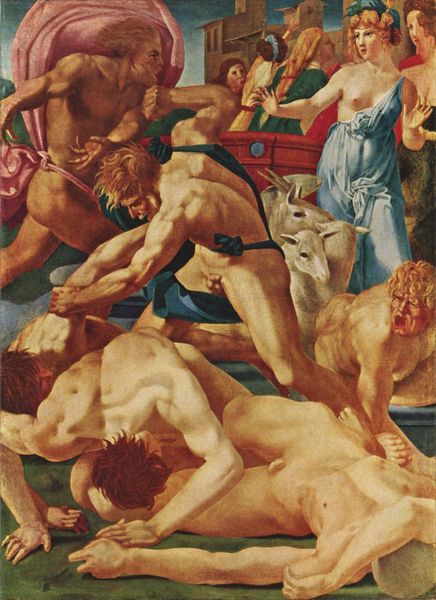
Moses Defending the Daughters of Jethro
Rosso Fiorentino was an Italian Mannerist painter, in oil and fresco, belonging to the Florentine school.
Rosso is the author of a painting of absolute originality. He is the leader of French Mannerism.
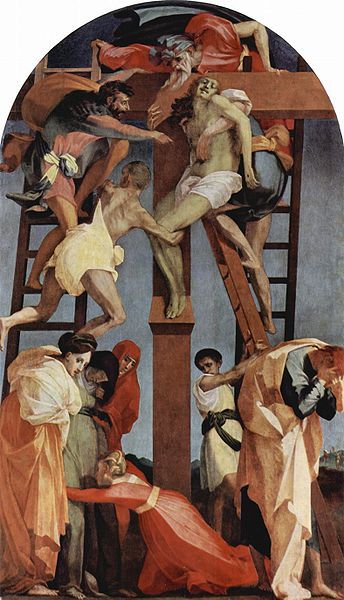
Deposition from the Cross
Artist: Rosso Fiorentino
Year: circa 1521
Type: Oil on wood
Dimensions: 375 cm × 196 cm (148 in × 77 in)
Location: Pinacoteca Comunale, Volterra
Unlike Pontormo's bright coloration and unitary collection of billowing figures, the Fiorentino depiction has two areas:
above is an Escher-like geometric struggle of laborers on ladders, mechanically removing the crucified Christ
While below, the women and men are subsumed in grief
Mary, pale and downcast, collapses in the arms of two women. Mary Magdalen in bright red swoons to hug Madonna's legs. A grief-stricken apostle turns his face away. The somber landscape is virtually barren.
One reviewer describes the scene as "violent suffering ...rendered by an extreme expression, the concatenation of angular bodies, and the dazzling light that sharply draws clear folds on the clothing."
Another states that this is the prototype of early-Mannerism, with "no logical spatial connection between the figures, the cross, and ladders; the size of the figures appears arbitrarily chosen, and their elongated bodies and small heads" distort classical proportions.
- Wikipedia His Deposition is today of an uncoachable modernity by its pre-Cézanne aspect.
Clothes folds turn into a volume.
Each face refers to a different angle of vision: the face of Christ is turned to the ground.
The powerful structuring of space by the Cross and the scales, as well as the disposition of the characters, induce a circulation of the gaze in a kind of dramaturgy.
The pathos of a Pietà who transformed compassion into an abstract spirituality in bright colors.
Expressionism with Nordic influences is much more accentuated here than in Pontormo.
Space is totally unreal. The characters stand in front of them without entering, like spectral appearances.
The harsh light, the singularly brilliant colors and the curves described by their members so long the distances of the naturalistic characteristics.
From surfaces illuminated in various ways, the geometric volumes of bodies are constructed and joined together forming acute angles.
Everything is intense and Rosso eliminates or transforms everything that could mitigate or compromise this exacerbation: space, perspective, masses, proportions...
#art#artist#art history#art history class#art history with Mihoki#painter#Italian Painting#oil painting#Rosso#rosso fiorentino#Firenze#Florence#Deposition#xvi century#religious#religion#mannerism#renaissance#high renaissance
0 notes
Text
Pontormo (1494 - 1556)
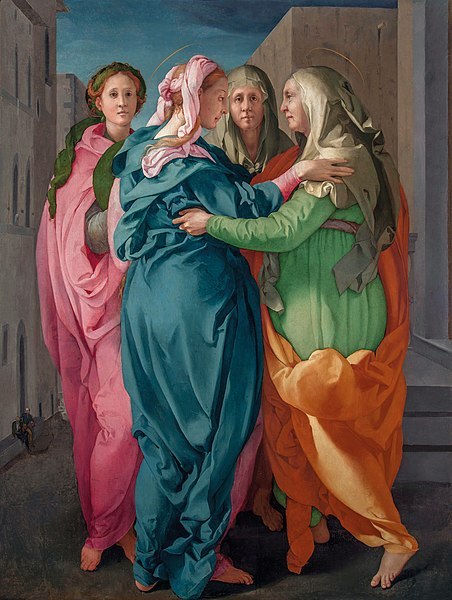
Visitation, 1528–29
Pontormo was an Italian Mannerist painter and portraitist from the Florentine School. His work represents a profound stylistic shift from the calm perspectival regularity that characterized the art of the Florentine Renaissance.
He is famous for his use of twining poses, coupled with ambiguous perspective; his figures often seem to float in an uncertain environment, unhampered by the forces of gravity.
- Wikipedia
He is the type of singular artist, melancholy, misanthropic and hypochondriac.
He was influenced by the German style.
His Pietà is recognized as splendid of colors. Its particular clarity was dictated by the great darkness of the chapel for which it was intended.
Pontormo's painting is no longer identifiable in the terms in force. No proportion, requirement of perspective.
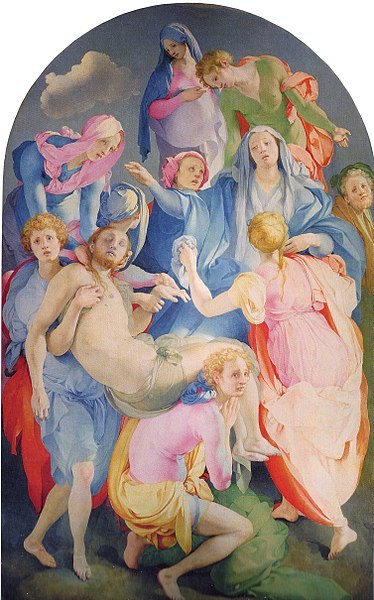
The deposition from the Cross
Artist: Jacopo Pontormo
Year: c. 1525–1528
Type: Tempera on wood
Dimensions: 313 cm × 192 cm (123 in × 76 in)
Location: Church of Santa Felicita, Florence
This painting suggests a whirling dance of the grief-stricken.
They inhabit a flattened space, comprising a sculptural congregation of brightly demarcated colors.
The vortex of the composition droops down towards the limp body of Jesus off center in the left. Those lowering Christ appear to demand our help in sustaining both the weight of his body (and the burden of sin Christ took on) and their grief. No Cross is visible; the natural world itself also appears to have nearly vanished: a lonely cloud and a shadowed patch of ground with a crumpled sheet provide sky and stratum for the mourners. If the sky and earth have lost color, the mourners have not; bright swathes of pink and blue envelop the pallid, limp Christ.
Pontormo's undulating mannerist contortions have been interpreted as intending to express apoplectic and uncontrolled spasms of melancholy.
The Virgin, larger than her counterparts, swoons sideways inviting the support of those behind her; the Swoon of the Virgin was a controversial moment at the time. The assembly looks completely interlocked, as if architecturally integrated.
Legend has it that Pontormo set himself in self-portrait at the extreme right of the canvas; but ultimately, the most compelling and empathic figure is the crouching man in the foreground, whose expression mixes the weight of the cadaver and the weight of melancholy.
- Wikipedia
The scene of the Pietà is ambiguous. We can identify the characters but the iconography remains undecided and has been the occasion of several hypotheses because it does not meet the usual norms:
Descent from the Cross without Believing
Laying without a tomb,
Pietà out of the arms of the Virgin
One sees then a moment of suspension, passage between life and death, separation of the two worlds ..
The Pietà contains several characteristics of Mannerism:
The feeling of confusion that presides over the characters gathered in a space that seems too small to contain them all
The multiplication of the directions of the looks and the different postures of each head which seem to call different points, outside the painting
The whirling movement induced by the gestures and the positions of the bodies
The absence of depth that precipitates the figures in front of the stage
The use of cold colors, even acid, and the disembodied feeling that emerges from the scene and gives a feeling of derealization.
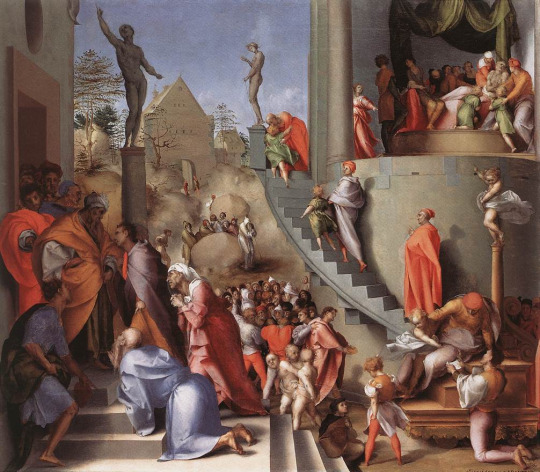
Joseph in Egypt
Artist: Jacopo Pontormo
Year: 1515-18
Type: Oil on wood
Dimensions: 96 x 109 cm
Location: National Gallery, London
In this panel the thesis proposed by Mannerism is fully elaborated: the painter is no longer to be bound by perspective, or by the necessity of presenting his subject in a rational, objective manner. He may use light and colour, chiaroscuro and proportion as he pleases; he may borrow from any source he chooses; the only obligation upon him is to create an interesting design, expressive of the ideas inherent in the subject, and the various parts need bear no relationship to each other. The colour must be evocative and beautiful in itself.
This work, traditionally entitled Joseph in Egypt, depicts the most significant episodes of Joseph reuniting with his family of origin. The painting is divided into four distinct zones.
In the left foreground Joseph presents his family, who he invited to move to Egypt, to the pharaoh; according to Vasari, the boy with dark cloak and brown tunic sitting on the first step of the stairs on which the figures are arranged, is a portrait of the young Bronzino.
On the right, Joseph is seen sitting on a triumphal cart pulled by three putti; hoisting himself up with his left arm and clutching firmly onto a putto with the other, he bends toward a kneeling figure who is presenting him a petition or reading him a message; a fifth putto, wrapped in a piece of cloth blown by the wind, dominates the scene from the top of a column, appearing to mime the gesture of one of the two half-living statues represented in the top left and centre of the painting.
A restless crowd, curious to see what is going on, throngs the adjacent space between the two buildings in the background.
Other mysterious figures, resting against one of the large boulders that dominate the landscape, turn their attention toward the action in the foreground.
The clothes, expressions and features of all these figures are inspired by northern European painting, as is the large castle and surrounding trees depicted in the background. On the unrailed staircase of the imposing cylindrical building to the right, Joseph takes one of his children by the hand; higher up, the other is greeted affectionately by his mother.
Lastly, Joseph and his sons, Ephraim and Manasseh, are portrayed inside the room at the top of the building, where Jacob, now old and near to death, imparts his paternal blessing. The curious combination of all these elements confers to the painting an anomalous and intriguing quality.
- wga.hu
Artificial character of Mannerist paintings. As in Joseph in Egypt. Artificial means that the scene no longer claims to represent a real scene, a place that would exist outside the painting.
In other words, the principle of the painting as "window" which governed the art of Quattrocento is no longer valid.
The simple Ambition of wanting to represent nature is substituted for something more complex.
#art#art history#art history class#art history with Mihoki#italian artist#Italian Painting#firenze#florence#pontormo#mannerism#xvi century#religious#Religion
1 note
·
View note
Text
Michelangelo (1475 - 1564)
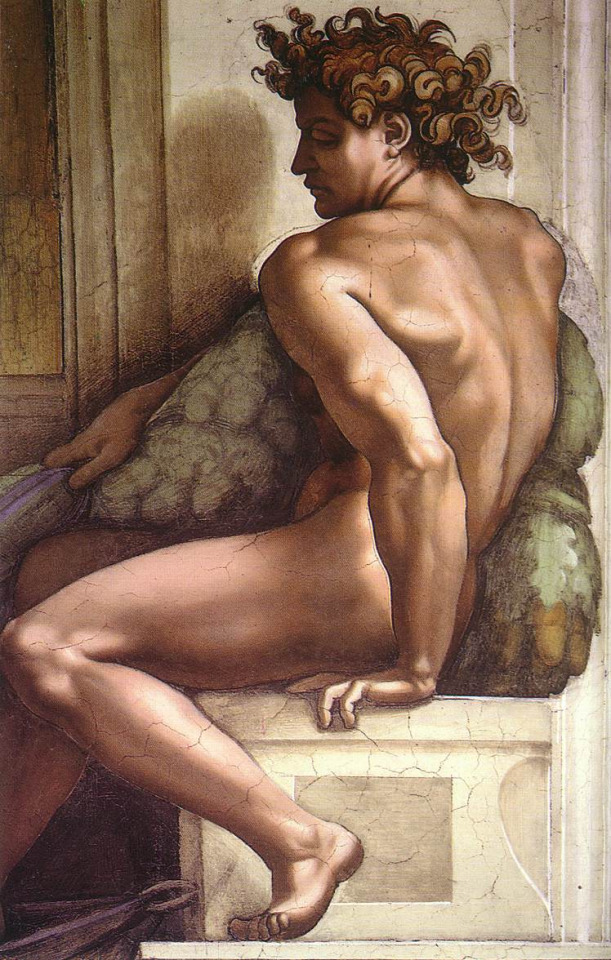
Michelangelo was an Italian sculptor, painter, architect, and poet of the High Renaissance born in the Republic of Florence.
He exerted an unparalleled influence on the development of Western art. Considered by many the greatest artist of his lifetime.
His contemporaries often admired his terribilità—his ability to instill a sense of awe. Attempts by subsequent artists to imitate Michelangelo's impassioned, highly personal style resulted in Mannerism, the next major movement in Western art after the High Renaissance.
- Wikipedia
He has dominated his era in the face of the figure of the artist in perpetual research, overwhelmed by an existential anxiety that can not be satisfied with the Quattrocento Classicism he calls into question.
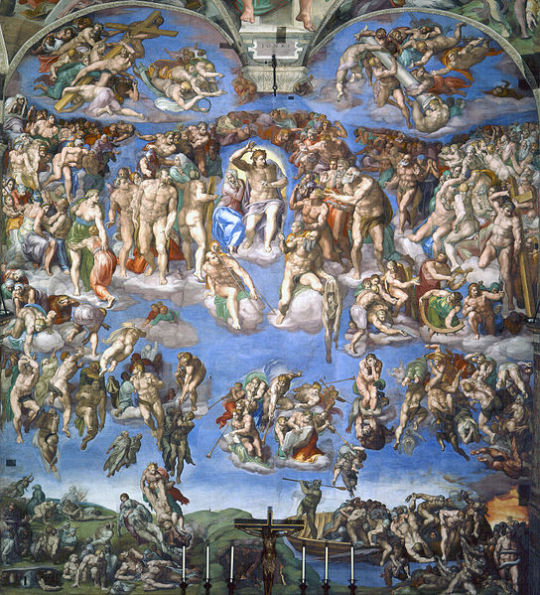
The Last Judgment
Artist: Michelangelo
Year: 1536–1541
Type: Fresco
Dimensions: 13.7 m × 12 m (539.3 in × 472.4 in)
Location: Sistine Chapel, Vatican City
The reception of the painting was mixed from the start, with much praise but also criticism of both religious and artistic grounds. Both the amount of nudity and the muscular style of the bodies has been one area of contention and the overall composition another.
In the lower part of the fresco, Michelangelo followed tradition in showing the saved ascending at the left and the damned descending at the right.
In the upper part, the inhabitants of Heaven are joined by the newly saved.
The fresco is more monochromatic than the ceiling frescoes and is dominated by the tones of flesh and sky.
The cleaning and restoration of the fresco, however, revealed a greater chromatic range than previously apparent. Orange, green, yellow, and blue are scattered throughout, animating and unifying the complex scene.
- Wikipedia
Movement and tension give the terrifying and chaotic aspect that express the anxiety of the souls waiting for the Judgment.
Michelangelo speaks of human destiny and anguish before death and Eternity.
The vision of an uncertain and anguishing future (only by the plastic expression), the entanglement of the bodies in a space saturated in true depth, this work contradicts the classical esthetics.
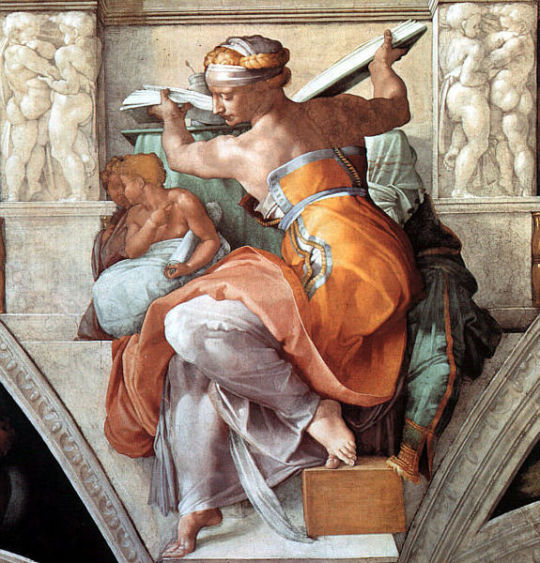
The Libyan Sibyl (1511)
Stripped of her outer garments, which he behind her against the back of her throne, the last and most regal of the sibyls turns in a superb contrapposto movement to close her book and replace it on its desk while she looks downward at the altar, ready to step from her throne.
The vast symphonic structure of Michelangelo's color is especially well seen in this illustration, ranging from the deep, rich tonalities of the spandrels and lunettes, intensifying the natural shadow of their positions, through the bright garments to the gray-white of the simulated marble.
The figure is dominated by an orange-lavender dialectic of throbbing intensity. The bodice is orange, with white highlights and reddish shadows; the rose lining is turned up to reveal a lavender shift, always the color of divinity on the Ceiling, punctuated by hanging gray scarves. The border and the belt of the bodice are gray with gold-yellow buttons. The outer dress before which Libyca sits is a splendid green, with yellow-gold
Michel Ange seizes the surface to evoke a skeleton and a world of gigantic figures, which are at the same time the incarnations of vital energies sealed in the vault.
He translates the material weight of the vault by the volume of its figures and the "relief" of the painted architecture.
Feeling of power by the torsion that inflicts on them the artist, a contained force.
Especially since these figures are part of the extraordinary structural tension that organizes all the frescoes.
- Michelangelo.org
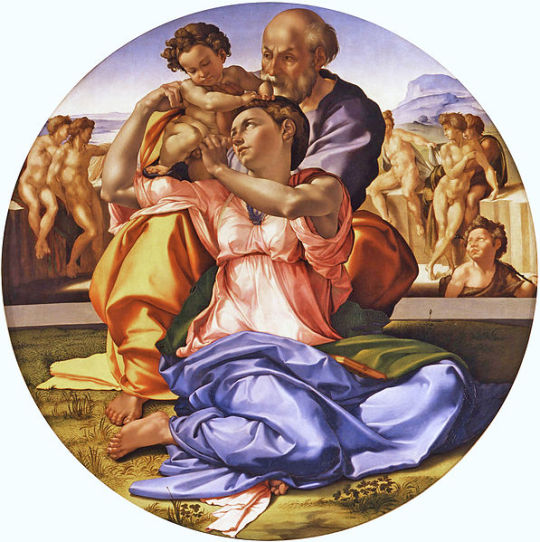
Doni Tondo (Doni Madonna) / Holy Family
Artist: Michelangelo
Year: circa 1507
Type: Oil and tempera on panel
Dimensions: 120 cm diameter ( 47 1⁄2 in)
Location: Uffizi, Florence
Mary is the most prominent figure in the composition, taking up much of the center of the image.
She sits directly on the ground without a cushion between herself and the grass, to better communicate the theme of her relationship to the earth.
Joseph is positioned higher in the image than Mary, although this is an unusual feature in compositions of the Holy Family.
Mary is seated between his legs, as if he is protecting her, his great legs forming a kind of de facto throne. There is some debate as to whether Mary is receiving the Child from Joseph or vice versa, although it is clear that the former is the case as she has put down the book she was reading.
Saint John the Baptist, the patron saint of Florence, is very commonly included in Florentine works depicting the Madonna and Child. He is in the middle-ground of the painting, between the Holy Family and the background. The scene appears to be a rural one, with the Holy Family enjoying themselves on the grass and separated from the curiously (seemingly) unrelated group at the back by a low wall.
There is a horizontal band, possibly a wall, separating the foreground and background. The background figures are five nudes, whose meaning and function are subject to much speculation and debate. Because they are much closer to us, the viewers, the Holy Family is much larger than the nudes in the background, a device to aid the illusion of deep space in a two-dimensional image.
Behind Saint John, the Baptist is a semi-circular ridge, against which the 'ignudi' are leaning, or upon which they are sitting. This semi-circle reflects or mirrors the circular shape of the painting itself and acts as a foil to the vertical nature of the principal group (the Holy family). Mary and Joseph gaze at Christ, but none of the background nudes looks directly at him.
The far background contains a mountainous landscape rendered in atmospheric perspective.
- Wikipedia
#art#art history#art history class#art history with Mihoki#italian artist#Italian Painting#firenze#florence#sistine chapel#Religion#religious#renaissance#high renaissance#michelangelo#michel ange#xvi century#xv century
1 note
·
View note